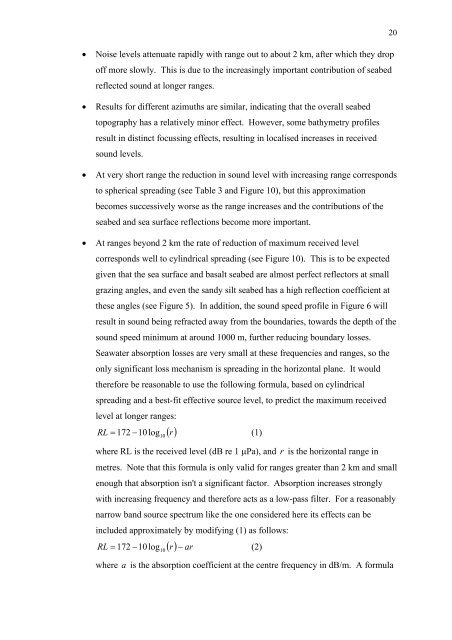Appendices 5-13 - Nautilus Cares - Nautilus Minerals
Appendices 5-13 - Nautilus Cares - Nautilus Minerals
Appendices 5-13 - Nautilus Cares - Nautilus Minerals
Create successful ePaper yourself
Turn your PDF publications into a flip-book with our unique Google optimized e-Paper software.
* Noise levels attenuate rapidly with range out to about 2 km, after which they drop<br />
off more slowly. This is due to the increasingly important contribution of seabed<br />
reflected sound at longer ranges.<br />
* Results for different azimuths are similar, indicating that the overall seabed<br />
topography has a relatively minor effect. However, some bathymetry profiles<br />
result in distinct focussing effects, resulting in localised increases in received<br />
sound levels.<br />
* At very short range the reduction in sound level with increasing range corresponds<br />
to spherical spreading (see Table 3 and Figure 10), but this approximation<br />
becomes successively worse as the range increases and the contributions of the<br />
seabed and sea surface reflections become more important.<br />
* At ranges beyond 2 km the rate of reduction of maximum received level<br />
corresponds well to cylindrical spreading (see Figure 10). This is to be expected<br />
given that the sea surface and basalt seabed are almost perfect reflectors at small<br />
grazing angles, and even the sandy silt seabed has a high reflection coefficient at<br />
these angles (see Figure 5). In addition, the sound speed profile in Figure 6 will<br />
result in sound being refracted away from the boundaries, towards the depth of the<br />
sound speed minimum at around 1000 m, further reducing boundary losses.<br />
Seawater absorption losses are very small at these frequencies and ranges, so the<br />
only significant loss mechanism is spreading in the horizontal plane. It would<br />
therefore be reasonable to use the following formula, based on cylindrical<br />
spreading and a best-fit effective source level, to predict the maximum received<br />
level at longer ranges:<br />
RL 172 -10log10<br />
+ r,<br />
) (1)<br />
where RL is the received level (dB re 1 "Pa), and r is the horizontal range in<br />
metres. Note that this formula is only valid for ranges greater than 2 km and small<br />
enough that absorption isn't a significant factor. Absorption increases strongly<br />
with increasing frequency and therefore acts as a low-pass filter. For a reasonably<br />
narrow band source spectrum like the one considered here its effects can be<br />
included approximately by modifying (1) as follows:<br />
+ r,<br />
ar<br />
RL 172 -10log<br />
-<br />
(2)<br />
) 10<br />
where a is the absorption coefficient at the centre frequency in dB/m. A formula<br />
20


